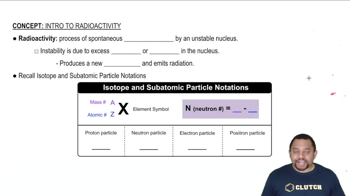The Ogallala aquifer described in the Closer Look box in Section 18.3, provides 82% of the drinking water for the people who live in the region, although more than 75% of the water that is pumped from it is for irrigation. Irrigation withdrawals are approximately 18 billion gallons per day. (b) What process or processes accounts for the presence of arsenic in well water?
Ch.18 - Chemistry of the Environment
Chapter 18, Problem 49
The organic anion

is found in most detergents. Assume that the anion under-goes aerobic decomposition in the following manner: C18H29SO3- + 51 O2 → 36 CO2(aq) + 28 H2O (l) + 2 H+(aq) + 2 SO42-(aq) What is the total mass of O2 required to biodegrade 10.0 g of this substance?
 Verified step by step guidance
Verified step by step guidance1
Step 1: Write down the balanced chemical equation for the decomposition reaction: C18H29SO3- + 51 O2 → 36 CO2(aq) + 28 H2O (l) + 2 H+(aq) + 2 SO42-(aq).
Step 2: Calculate the molar mass of the organic anion C18H29SO3-. Use the atomic masses: C (12.01 g/mol), H (1.01 g/mol), S (32.07 g/mol), and O (16.00 g/mol).
Step 3: Determine the number of moles of the organic anion in 10.0 g by dividing the mass by the molar mass calculated in Step 2.
Step 4: Use the stoichiometry of the balanced equation to find the moles of O2 required. According to the equation, 1 mole of C18H29SO3- reacts with 51 moles of O2.
Step 5: Calculate the total mass of O2 required by multiplying the moles of O2 (from Step 4) by the molar mass of O2 (32.00 g/mol).

Verified video answer for a similar problem:
This video solution was recommended by our tutors as helpful for the problem above.
Video duration:
2mWas this helpful?
Key Concepts
Here are the essential concepts you must grasp in order to answer the question correctly.
Stoichiometry
Stoichiometry is the calculation of reactants and products in chemical reactions. It involves using balanced chemical equations to determine the relationships between the quantities of substances involved. In this case, stoichiometry will help calculate the amount of O2 needed to completely react with a given mass of lauryl sulfate based on the provided reaction.
Recommended video:
Guided course

Stoichiometry Concept
Molar Mass
Molar mass is the mass of one mole of a substance, typically expressed in grams per mole (g/mol). It is essential for converting between the mass of a substance and the number of moles, which is necessary for stoichiometric calculations. For lauryl sulfate (C18H29SO3-), knowing its molar mass allows us to determine how many moles correspond to the 10.0 g given in the question.
Recommended video:
Guided course

Molar Mass Concept
Aerobic Decomposition
Aerobic decomposition is the breakdown of organic matter by microorganisms in the presence of oxygen. This process results in the production of carbon dioxide, water, and other byproducts. Understanding this concept is crucial for interpreting the reaction provided, as it highlights the role of O2 in the biodegradation of lauryl sulfate and the overall environmental impact of detergents.
Recommended video:
Guided course

Intro to Radioactivity
Related Practice
Textbook Question
5
views
Textbook Question
Magnesium ions are removed in water treatment by the addition of slaked lime, Ca(OH)2. Write a balanced chemical equation to describe what occurs in this process
1
views
Textbook Question
In the lime soda process once used in large scale munici-pal water softening, calcium hydroxide prepared from lime and sodium carbonate are added to precipitate Ca2+ as CaCO3(s) and Mg2+ as Mg(OH)2(s): Ca2+(aq) + CO32-(aq) → CaCO3(s) Mg2+(aq) + 2 OH-(aq) → MgOH2(aq) How many moles of Ca(OH)2 and Na2CO3 should be added to soften (remove the Ca2+ and Mg2+) 1200 L of water in which [Ca2+] = 5.0x10-4 M and [Mg2+] = 7.0x10-4 M?
Textbook Question
(a) What are trihalomethanes (THMs)? (b) Draw the Lewis structures of two example THMs.
